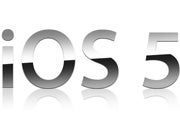The 5 best features in Apple's iOS 5
Earlier this week at its Worldwide Developers Conference (WWDC), Apple finally offered up alook at iOS 5, the planned update to the company's mobile OS. Although it wont be out until this fall -- Apple isn't yet saying exactly when -- iOS 5 promises to deliver much-needed changes to the OS, which is used on the iPhone, iPad and iPod touch.
Apple told WWDC attendees that the new OS will have some 200 new features, though only 10 of them were showcased during Monday's two-hour keynote, which also focused on iCloud and OS X 10.7 "Lion."
Here are the five iOS 5-based changes I'm looking forward to most.
New notifications
Let's start with the crowd-pleaser: Apple has finally revamped the way iOS handles message notifications. This was long overdue.
Until now, whenever a notification arrived, it popped up on the screen, forcing you to either view the message or close the notification window. The new method doesn't force you to stop whatever you're doing; the notification literally rotates into view in the form of an unobtrusive banner beneath the menu bar. Within seconds, the banner -- it displays the appropriate app icon and the message -- gently flips back out of view. If the notification requires immediate attention, tapping it automatically switches you to the app so you can respond.
Don't worry if you liked the current style of modal notifications. They haven't been cut completely. In iOS 5 they'll still be an option when you configure your apps under Settings>Notifications. And they're still useful in certain situations. After all, not all notifications should be ignored -- like a reminder to take medicine. But I suspect most users will opt for the less intrusive banner, which is selected by default.
If you want to retrieve any notifications you've ignored, you use Apple's new Notification Center, a completely original idea that no one has ever thought of. (That sound, by the way, was hundreds of Android fans' heads bursting.)
I kid, of course; The notification screen isn't particularly original or new to anyone except iOS users who haven't modified their system software, but that doesn't make its inclusion any less welcome. Swiping your finger down from the top of the iPhone screen slides open the Notification Center, where all of your alerts are organized by app. (Apple also added in Stocks and Weather widgets.) You remove older notifications by hitting an X and then confirming that you want to make the app entries go away by tapping Clear.
Making the new system more useful, customizations are available on a per-app basis in the Notification Settings area. You can sort notifications manually or by time, and you can edit the display order of the apps. One thing to keep in mind if you can't pull yourself away from certain apps: You can set the apps to display banner notifications and on the Lock Screen. That'll be handy, since you won't have to spend time unlocking the phone just to check notifications.
Revamped Lock Screen
The Lock Screen will get a few fairly useful updates in iOS 5. Double-tapping the Home button not only brings up audio options like before, but now it adds a Camera icon just to the right of the Swipe to Unlock slider. This gives quick access to the Camera app -- even when the iPhone is locked -- allowing you to record pictures and videos much faster than before. This means no more fumbling to unlock the phone, launch the Camera app and snap a picture. As a bonus, the volume up button doubles as a hardware shutter. (Somewhere, Windows Phone 7 fans are screaming with rage; this was on Microsoft's mobile devices first.)
As a security measure, when an iPhone is locked with a passcode, access to the Camera app is still available -- but only to the Camera app. The ability to browse photos already taken -- or poke around on the phone further -- is restricted.
The Notification Center is also part of the Lock Screen, and everything you may have missed displays on a darkly tinted layer over your Lock Screen picture. Depending on the options you choose, you'll see text messages show who messaged and what they said; phone calls and voicemails; and even emails with snippets of the messages. And every alert is time stamped.
To quickly jump to any given app requiring your attention, slide the app icon for that particular notification and that's the app that opens when the iPhone is unlocked. It's a simple idea well implemented. It's amazing how effectively implemented features add up to a better iOS user experience without needless complexity.
Cutting the cord
A few months before WWDC, Apple CEO Steve Jobs said that the post-PC era is beginning. Clearly, given Apple's recent burst of sales, he must have meant the "post-reliance-on-Microsoft era," especially since iOS devices don't work without first plugging them into a computer running iTunes. But Jobs was serious about the idea of standalone devices, and iOS 5 paves the way for a future in which devices like the iPad, iPhone, and iPod touch serve as your sole computer.
Out of the box, an iOS 5 device can be activated without plugging it into anything. After entering basic information like your Apple ID, you can then access every purchase you've made through iTunes (including the music, movie, and app stores) and download them as quickly as your connection allows.
Not only is activation done wirelessly; so are iOS updates. Effectively, this eliminates iTunes as required middleware.
There is, however, a benefit to plugging in an iOS device to iTunes: the automatic backup that happens before each sync. It's been a life-saver for me more times than I'd like to admit. Apple engineers have another option for iOS 5 users, though, and it's pretty simple. Since most users plug in their phone before bed to charge overnight, Apple is touting a system that allows the device to automatically back itself up to iTunes via Wi-Fi while charging. Once it's finished that, it'll sync iTunes content wirelessly.
Having the iPhone, iPad, and iPod touch serve as a standalone computers effectively opens the door for more sales. In some parts of the world, the iPhone hasn't caught on because of the necessary computer-linking; if you don't have a computer, you've got a problem. This should change that.
Messages
One surprise at WWDC was the introduction of the Messages app, which effectively replaces text/SMS/MMS messaging from one IOS device to another. Not only does Messages work across all of Apple's iOS 5 products, but it could save you money by bypassing a major revenue source for carriers (text and multimedia messages) using Apple-based, encrypted tech.
iPhones have always been able to send and receive text messages, and, since the iOS 3 update, picture and movie messages, too. The problem with this is that carriers charge ridiculous rates for texting. Currently, AT&T sells separate messaging plans, and unlimited messaging is $30 a month. Well, if your family has iPhones and your friends have iPhones, you can use Messages on all of them and you don't pay a dime. There's no cost for sending text, images or movies -- as long as the messages are between two iOS devices.
If the recipient isn't using an Apple device, the message (or file) is sent by standard SMS, which is then color-coded to green. iOS to iOS messages are blue and actually state "iMessages" at the top of the message and in an empty text entry field. But wait, there's more: the iMessages service syncs conversations between devices automatically, so you can start a conversation on the iPhone and pick it up later on an iPad if you want.
There are other nice touches included, including group messaging, encrypted chat, read receipts, and the ability to link messages to more than one email address.
If you and those you know send text/SMS/MMS messages to each other iOS devices, this is a sure-fire winner.
AirPlay
AirPlay is already a brilliant feature. As a matter of fact, it's what I used to watch the WWDC keynote after it was posted on the Apple site. From my couch, I browsed to Apple.com on the iPad, called up the Keynote movie, and beamed it to my entertainment system and big screen. But it's limited to streaming movies and audio, and even then, only in apps that support AirPlay streaming. But what about when you'd like to present an entire app and its contents? AirPlay in iOS 4 doesn't help, though Apple sells a $40 adapter that allows video mirroring on the iPad 2.
As of iOS 5, AirPlay now mirrors the iPad directly with AirPlay Mirroring. To enable it, just double-tap the Home button, swipe right to call up the brightness/volume/rotation lock area, tap the AirPlay button -- the icon resembles a TV -- tap your destination device for the video and turn on mirroring when the option slides into view.
This is not only useful for classroom, business presentations and group training sessions, but this leaves open the possibility for Apple to become a player in the living room gaming console wars.
Oh, and one more thing
The big news from WWDC was, of course, iCloud, which will play a major role in the success of iOS 5, and which analysts already say will help Apple fend off Google and Android.
Apple's iCloud arrives at a time when people are surrounded by screens. There's a screen at home, a screen at work, a screen in your pocket, and not all of these devices talk to each other. Syncing and storage services like Drop Box and iDisk give users a central location to store docs online, but using those services requires actually being aware of them, and then manually copying over files for later retrieval.
Apple engineers eyed data and the problem with keeping computers and devices up to date and in sync. The solution they came up with is a collection of services that syncs all data between your devices -- iPads, iPhones, iPods touch, and Windows PCs and Macs -- without ever doing anything. That's essentially what iCloud does.
The ability to have up-to-date data across all devices, without worry or extra steps, is a huge deal. Some of Apple's apps provide similar functionality now; iBooks, for instance, syncs pages, bookmarks and notes across iOS apps, so no matter how you access the book you're reading, you're always where you left off. In iOS 5, Apple will bring that capability to every app. If you're editing a quick Keynote presentation on your iPhone in the taxi, you can pick up where you left off on the office Mac -- your presentation will already be there when you walk in. Game data will sync, too, so you can launch Angry Birds on the iPad and keep going on your iPhone.
Every bit of data is synced with iCloud and pushed out to other devices, and it's all automatic. You don't think about it, or do anything; it just happens.
There's 5GB of storage allocated for every iCloud user, but music, apps, books, Photo Stream photos (which automatically syncs photos across your devices) don't count toward the storage usage.
Apple engineers have made past attempts to abstract the file system in the past, sometimes culminating in clumsy results (I'm looking at you, File Sharing to iOS devices in iTunes). It's no accident that the iPhone and iPad lack a user-accessible file system, and with iCloud, Apple may have found a way to justifiably resist adding file system access.
Final thoughts
iOS 5 brings about dozens of welcome changes that users at all experience levels will appreciate, and, most importantly, will actually use. Apple consistently shows that powerful new features don't necessarily mean added complexity; the updates that are coming with iOS 5 -- while not entirely original -- reiterate that fact.
Almost as importantly, the changes solidify the role of iOS in the overall Apple ecosystem and the part iCloud will play in neatly tying together the plethora of devices people use every day.





0 comments:
Post a Comment